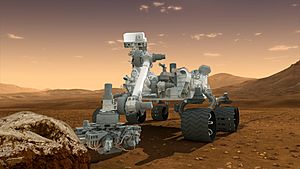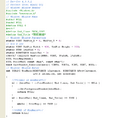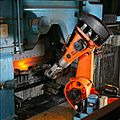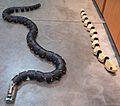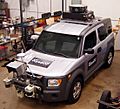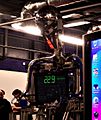Robotics facts for kids
Robotics is a cool part of engineering and science. It's all about designing, building, and using robots. It also involves teaching robots what to do using computer programming. Robotics combines different types of engineering, like mechanical and electrical engineering.
Robots are often used for jobs that are too dangerous, difficult, or far away for humans. For example, they can help find and get rid of bombs, or explore places that are too hot, too small, or too distant. While some robots might look a bit like humans, most of them look more like special machines.
The word "robotics" comes from the word "robot." The word "robot" itself comes from the Slavic word robota, which means "labor" or "work." A writer named Karel Čapek first used the word "robot" in his play called R.U.R. (Rossum's Universal Robots). Later, the famous science fiction writer Isaac Asimov used the word "robotics" for the first time in his story "Liar!", which was published in 1941.
Contents
What is a Robot?
A robot is a machine that can do tasks automatically. It can be controlled by a computer program or by a human. Robots are designed to help people or to do jobs that are hard or risky. They can be found in many places, from factories to outer space!
How Robots Work
Robots usually have three main parts:
- Body: This is the physical structure of the robot, like its frame, wheels, or arms.
- Brain: This is the computer system that controls the robot. It tells the robot what to do and how to move.
- Sensors: These are like the robot's "eyes" and "ears." Sensors help the robot understand its surroundings. They can detect light, sound, touch, distance, and more.
Robots use their "brain" to process information from their "sensors." Then, they use their "body" to perform actions. For example, a robot might use a camera (sensor) to see an object. Its computer (brain) then tells its arm (body) to pick up the object.
Types of Robots
There are many different kinds of robots, each designed for specific tasks.
Industrial Robots
These robots are used in factories to build things. They can do jobs like welding, painting, or assembling cars. Industrial robots are very strong and can work quickly and precisely. They help make products faster and safer.
- Examples: Robotic arms in car factories.
Mobile Robots
Mobile robots can move around their environment. They often use wheels, tracks, or even legs to get around.
- Examples:
- Rovers: Like the robots exploring Mars, such as Curiosity. They gather information about other planets.
- Autonomous Vehicles: Cars that can drive themselves.
- Delivery Robots: Robots that bring food or packages to your door.
Humanoid Robots
These robots are designed to look and sometimes act like humans. They can walk on two legs and have arms and a head. Humanoid robots are often used for research, entertainment, or to help people in daily life.
- Examples: Robots that can play sports or interact with people.
Medical Robots
Robots are also used in hospitals and healthcare. They can help doctors perform surgeries with great precision. Some robots help nurses by delivering medicines or supplies.
- Examples: Surgical robots, pharmacy robots.
Exploration Robots
These robots go to places that are dangerous or impossible for humans to reach. This includes deep oceans, volcanoes, or other planets.
- Examples: Underwater robots, space probes.
History of Robotics
People have dreamed about creating machines that could do work for a long time.
- Ancient Ideas: Even in ancient times, inventors imagined automatic devices.
- 18th Century: Some early mechanical toys and figures could perform simple movements.
- Early 20th Century: The word "robot" was first used in a play in 1920.
- Mid-20th Century: The first industrial robots appeared in factories in the 1960s. These robots changed how products were made.
- Today: Robotics is a fast-growing field. Robots are becoming smarter and more common in our daily lives. They help us in many ways, from cleaning our homes to exploring distant planets.
The Future of Robotics
Robotics is always changing and improving. Scientists and engineers are working on making robots even more helpful and intelligent. In the future, robots might be able to:
- Learn and adapt to new situations even better.
- Work more closely with humans in homes and workplaces.
- Help solve big problems like climate change or healthcare challenges.
It's an exciting time for robotics, and new discoveries are happening all the time!
Images for kids
-
The InSight lander with its solar panels, being prepared in a clean room before going to Mars.
-
A KUKA industrial robot working in a factory that makes metal parts.
-
TALON military robots, used by the United States Army for dangerous tasks.
-
RuBot II, a robot that can solve Rubik's cubes very quickly.
-
TOPIO, a humanoid robot, playing ping pong at an exhibition.
-
The SCORBOT-ER 4u, a robot used for education.
See also
 In Spanish: Robótica para niños
In Spanish: Robótica para niños


